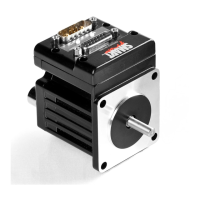Moog Animatics SmartMotor™ Developer's Guide,Rev. L
Page 234 of 909
Setting KP
The main objective in tuning a servo is to get the KP (proportional coefficient) value as high as
possible, while maintaining stability. The higher the KP value, the stiffer the system and the
more "under control" it is. Also, when initially setting KP, it is a good idea to start with KI
equal to zero (for details, see Setting KI and KL on page 234).
To begin, use the RKP (report KP) command to view the current setting and then increase it by
10% to 20%. For example:
RKP 3000 'Report current KP value
KP=3500 'Increase KP value
F 'Load new value into PID filter
Each time KP is raised, try to physically destabilize the system by bumping it, twisting it or
using a looping program that invokes abrupt motions. As long as the motor always settles to a
quiet rest, keep raising KP.
NOTE: If the SMI Tuning Utility is being used, it will employ a step function and
graphically show the reaction.
Setting KD
As soon as the SmartMotor starts to find it difficult to maintain stability, find the appropriate
value for KD(derivative compensation).
To do this, use the RKD(report KD command) to view the current value. Then move KD up and
down until a value is found that gives the quickest stability. Remember to use the F command
to update the new value.
Note that if KD is too high, there will be a grinding sound — it is not really grinding, but it is a
sign to go the other way. A properly-tuned motor is not only stable but reasonably quiet. The
level of noise immunity in the KD term is controlled by KS (velocity filter option for KD).
The derivative term KD requires estimating the derivative of the position error. The simplest
method is a backward difference, KS=0, which is no velocity filtering and can result in
excessive noise. The choices of KS=1, 2 and 3 provide increasing levels of noise immunity
(velocity filtering) at the expense of increasing latency. Because higher latency typically
results in lower achievable PID loop gains, choose the best compromise between smoothness
and tracking performance. The default setting is KS=1.
After optimizing KD, it may be possible to raise KP a bit more. Keep going back and forth
between KPand KD until you've maximized the stiffness of the system. After that, it’s time to
take a look at KI.
Setting KI and KL
Typically, KI (integral coefficient) is used to compensate for friction; without it, the
SmartMotor will never exactly reach the target. Begin with KI equal to zero and KL equal to
1000. Move the motor off target and start increasing KI and KL. Keep KL at least ten times
greater than KI during this phase. Use the RKI (report KI) and RKL (report KL) commands to
view the values; use the F command to update changes to the values.
Continue to increase KI until the motor always reaches its target. When that happens, add
about 30% to KI and start bringing down KL until it prevents the KI term from closing the
position precisely on target. After that point is reached, increase KL by about 30%. The
integral term needs to be strong enough to overcome friction. However, the limit needs to be
Part 1: Programming: Setting KP

